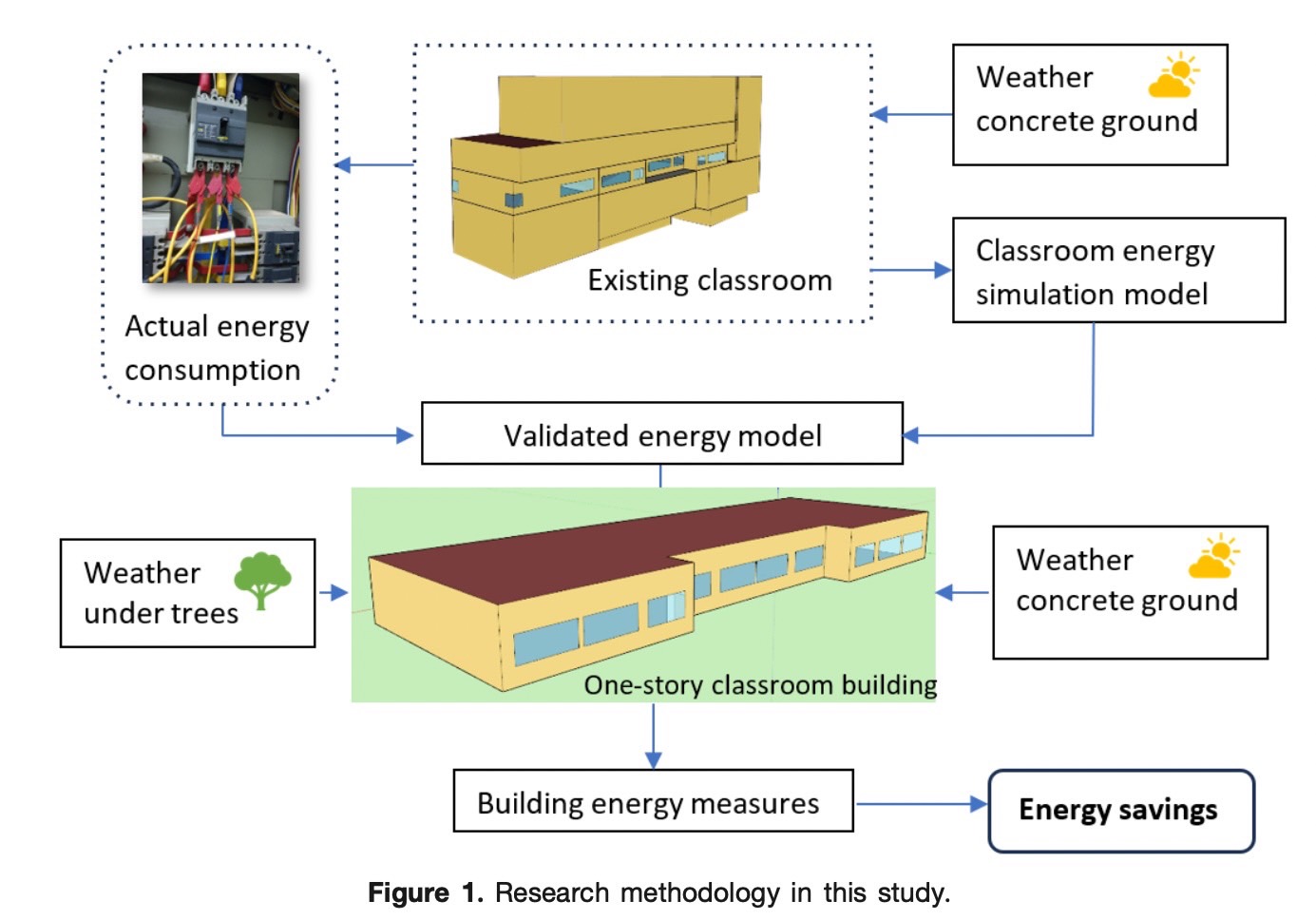Microclimate Effect on Cooling Energy for Buildings in Hot, Humid Climates: A Comparative Analysis of Shaded and Unshaded Environments
Main Article Content
Abstract
This paper explores the influence of microclimates on changes in air temperature and the often-overlooked aspect of their effect on energy savings across varying microclimatic conditions. The study compares the cooling energy requirements of two identical single-story buildings in distinct microclimates: one characterized by concrete ground devoid of shade and the other featuring soil ground with tree shade. Climatic environmental data were collected over 15 days in the concrete-exposed field and shaded area beneath the trees to conduct the investigation. These datasets were input into EnergyPlus 9.6 to model the energy demands and consumption of buildings subject to the specified climatic conditions. The validation of the simulated model against actual energy demand data from a classroom building demonstrated agreement. The findings reveal notable differences in air temperature, with the shaded area experiencing temperatures 0.8°C to 8.0°C lower than the concrete-exposed monitoring location. The building in the tree-shaded microclimate exhibited a lower peak cooling load than its concrete-exposed counterpart, resulting in a 35% reduction in the electrical energy requirements for the air-conditioning system. The study recommends implementing 0.08-m polyurethane insulation for the building walls and roof to equalize the energy demand and consumption of the concrete-exposed building with that of its shaded counterpart. Furthermore, building design in shaded areas can maximize the window glass area while consuming less energy than buildings on concrete-exposed grounds. The study advocates leveraging the microclimate associated with surrounding buildings in the design process to enhance the overall energy savings.
Downloads
Article Details

This work is licensed under a Creative Commons Attribution-NonCommercial-NoDerivatives 4.0 International License.
All material is licensed under the terms of the Creative Commons Attribution 4.0 International (CC-BY-NC-ND 4.0) License, unless otherwise stated. As such, authors are free to share, copy, and redistribute the material in any medium or format. The authors must give appropriate credit, provide a link to the license, and indicate if changes were made. The authors may do so in any reasonable manner, but not in any way that suggests the licensor endorses you or your use. The authors may not use the material for commercial purposes. If the authors remix, transform, or build upon the material, they may not distribute the modified material, unless permission is obtained from JARS. Final, accepted versions of the paper may be posted on third party repositories, provided appropriate acknowledgement to the original source is clearly noted.
References
Allegrini, J., & Carmeliet, J. (2017). Coupled CFD and building energy simulations for studying the impacts of building height topology and buoyancy on local urban microclimates. Urban Climate, 21, 278–305.
Brozovsky, J., Radivojevic, J., & Simonsen, A. (2022). Assessing the impact of urban microclimate on building energy demand by coupling CFD and building performance simulation. Journal of Building Engineering, 55, 104681.
Canbing L., Jinju Z., Yijia C., Jin Z., Yu L., Chongqing K., & Yi, T. (2010). Interaction between urban microclimate and electric air-conditioning energy consumption during high temperature season, Applied Energy, 117(2),149-156. https://doi.org/10.1016/j.apenergy.2013.11.057
Donovan, G. H. (2009). The value of shade: Estimating the effect of urban trees on summertime electricity use. Energy and Buildings, 41(6), 662-668.
Gómez-Muñoz, V. M. (2009). Effect of tree shades in urban planning in hot-arid climatic regions. Landscape and Urban Planning, 94(3-4), 149-157.
Hsieh, C-M., Li, J-J., Zhang, L., & Schwegler, B. (2018). Effects of tree shading and transpiration on building cooling energy use, Energy and Buildings, 159. 382-397. https://doi.org/10.1016/j.enbuild.2017.10.045.
Ministry of Energy. (2009). Energy Conservation Promotion Act BE 2552. Ministerial Regulation prescribes the types or sizes of buildings and standards, criteria, and methods for designing buildings for energy conservation.
Mosteiro-Romero, M., Maiullari, D., Pijpers-van Esch, M., & Schlueter, A. (2020). An integrated microclimate-energy demand simulation method for the assessment of urban districts. Frontiers in Built Environment, 6(94).
Nantarat, P., Charoentrakulpeeti, W., & Wattanapinyo, A. (2021). The efficiency of urban heat island mitigation by cooling effects from greenspace in Chiang Mai municipality. Journal of Architectural/Planning Research and Studies, 18(1), 131-152.
Prasitreak, D. & Srivanit, M. (2022). The effects of high-rise building on urban thermal environments and outdoor thermal Comfort: A case study of suburban residential development nearby the Rangsit Campus of Thammasat University. Journal of Architectural/Planning Research and Studies, 19(1), 41-63.
Qingjuan, Y., Wanyi, S., & Ziqi, L. (2022). A microclimate model for plant transpiration effects. Urban Climate, 45, 101240.
Rouhollahi, M., Whaley, D., Byrne, J., & Boland, J. (2022). Potential residential tree arrangement to optimise dwelling energy efficiency. Energy & Buildings, 261, 111962.
Salvati, A. (2017). Assessing the urban heat island and its energy impact on residential buildings in Mediterranean climate: Barcelona case study. Energy and Buildings, 146, 38-54.
Shen, P., & Wang, Z. (2020). How neighborhood form influences building energy use in winter design condition: Case study of Chicago using CFD coupled simulation. Journal of Cleaner Production, 261, 121094.
Srisuwan, P. (2011). Air quality with high air leakage when using an external air supply system. [Unpublished Master’s thesis]. Thammasat University.
Thai Meteorological Department. (2022). Weather Data Report.
U.S. Department of Energy. (2024). EnergyPlus™ Version 24.1.0 Documentation.
Wu, Z., Dou, P., & Chen, L. (2019). Comparative and combinative cooling effects of different spatial arrangements of buildings and trees on microclimate. Sustainable Cities and Society, 51, 101711.
Xiaoma L., Yuyu, Z., Sha, Y., Gensuo J,, Huidong L., & Wenliang L. (2019). Urban heat island impacts on building energy consumption: A review of approaches and findings, Energy, 174, 407-419. https://doi.org/10.1016/j.energy.2019.02.183.


